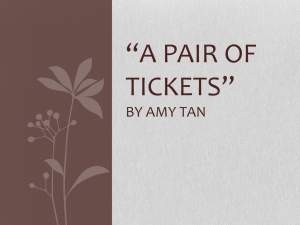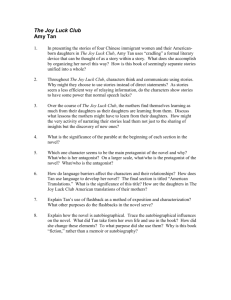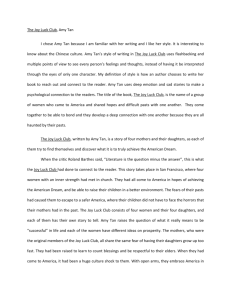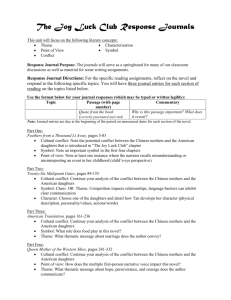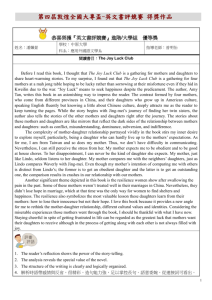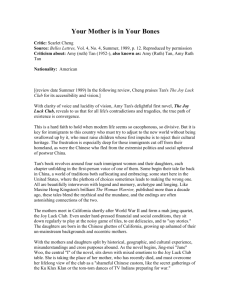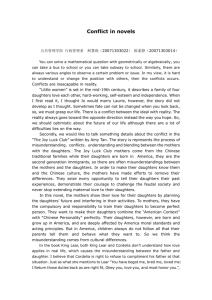Language as Barrier and Bridge in Amy Tan's The Joy Luck
advertisement
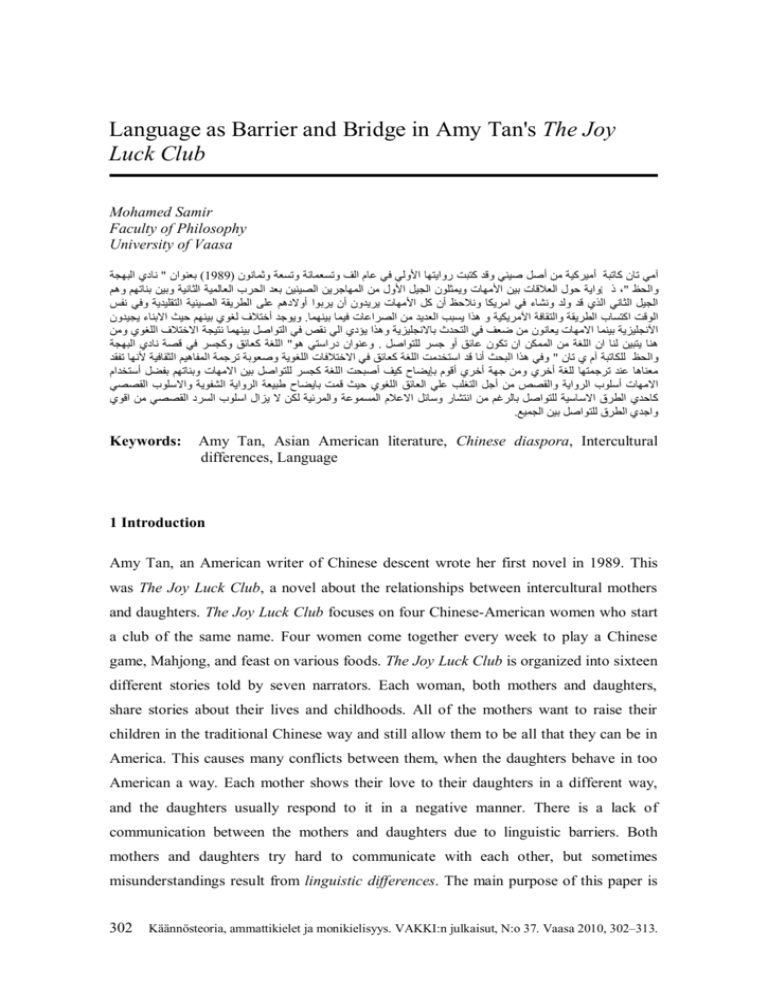
Language as Barrier and Bridge in Amy Tan's The Joy Luck Club Mohamed Samir Faculty of Philosophy University of Vaasa " (1989) 1 " . " . " . Keywords: Amy Tan, Asian American literature, Chinese diaspora, Intercultural differences, Language 1 Introduction Amy Tan, an American writer of Chinese descent wrote her first novel in 1989. This was The Joy Luck Club, a novel about the relationships between intercultural mothers and daughters. The Joy Luck Club focuses on four Chinese-American women who start a club of the same name. Four women come together every week to play a Chinese game, Mahjong, and feast on various foods. The Joy Luck Club is organized into sixteen different stories told by seven narrators. Each woman, both mothers and daughters, share stories about their lives and childhoods. All of the mothers want to raise their children in the traditional Chinese way and still allow them to be all that they can be in America. This causes many conflicts between them, when the daughters behave in too American a way. Each mother shows their love to their daughters in a different way, and the daughters usually respond to it in a negative manner. There is a lack of communication between the mothers and daughters due to linguistic barriers. Both mothers and daughters try hard to communicate with each other, but sometimes misunderstandings result from linguistic differences. The main purpose of this paper is 302 Käännösteoria, ammattikielet ja monikielisyys. VAKKI:n julkaisut, N:o 37. Vaasa 2010, 302–313. Language as Barrier and Bridge in Amy Tan’s The Joy Luck Club to focus on the linguistic differences and the challenges of cultural translation as a barrier, on the other hand the power of storytelling as a bridge. I approach the relationship between the mothers and daughters as a main theme of the discussion. In the novel, the communication between mothers and daughters is not only disturbed by generational differences. Most important is the barrier of two cultures clashing; the older Chinese culture and the present American culture (Shear 1993: 194). Moreover, the mothers and daughters have to overcome the class difference that has come between them. The Chinese mothers have always been manual labourers, whereas the daughters have had the opportunity to educate themselves and climb the social ladder. Therefore, racial, cultural, and class differences between mother and daughter influence their individual interpretation of situations and cause miscommunication and misunderstanding. In this paper I am employing the concept of storytelling as power. According to Chinese beliefs, the spirit of the mother fuses with the spirit of the daughter. In this respect, all mothers feel they have failed in giving their daughters great strength and spirit so far and need to make amends. Their individual decision to tell stories and let the daughters in on their secrets and histories is their last attempt to bridge the gap between cultures, generations and language and restore the brittle relationship between a mother and a daughter. 2 Theoretical Framework The theoretical framework of this study is the feminist psychoanalytical theory created by Nancy Chodorow in The Reproduction of Mothering (1978). Chodorow provides a psychological analysis of female identity derived from the Freudian Oedipus model, although she predominantly relies on object-relations psychology, which is based on the assumption that every individual’s psychological life is created in and through personal relationships with others. Chodorow claims that female identity is primarily based on the connection and closeness to the mother and the placement of women in culture is defined by the bonding between mother and daughter (1978: 100). This notion will be discussed in connection the emergence of women’s diaspora, a whole new field that has developed in recent years. Not only is feminist psychoanalysis used for creating an understanding of the world in general, but it is also used as a framework from which 303 Mohamed Samir reflections of the world could be analysed, such as literary fiction. Amy Tan gives voice to either a daughter or a mother and her clear description of the mothers’ and daughters’ perspectives provides the opportunity to get along well together. The reader realises that their relationship is influenced by a generation gap which is not merely created because of age differences but also because of cultural differences. The position of women in the Chinese culture influences the perception of female identity by the mothers and this clashes with the view of the daughters, who have been raised in a double culture (American Chinese culture). 3 The Linguistic Differences between Mothers and Daughters Reading the novel in English, we may forget that the mothers are speaking Chinese because of their English is undoubtedly imperfect. Subjects, articles, and prepositions are often missing. Verbs often do not agree with nouns. After, for instance, Waverly becomes angry at Lindo Jong for bragging about her in the marketplace, Lindo says: “So shame be with mother? Embarrass you be my daughter?” Waverly desperately tries to explain: “That's not what I meant. That's not what I say.” Lindo persists: “What you say?” (Tan 1989: 59.) Further communication at this point is impossible. Mother and daughter do not talk to each other for several days after the incident. This fact shows how unimportant differences in language can be: mothers and daughters express themselves vividly whether in English or Chinese. However, this fact also reminds us of how much of the mothers’ intentions are lost to English speakers, including their daughters. They seem uneducated when they speak English, unable to pronounce words, but are really deep reservoirs of knowledge. Many things in Chinese culture have no real English equivalent, such as (chunwang chihang) and (nengkan). These ideas seem foreign to the daughters; they understand them but often consider them specific to their mothers’ generation. Chodorow suggests that the social and gendered process of mothering can be detached from other processes, such as the influence of race and class. Many have questioned the possibility of separating the analyses of society, gender, race and class and have stressed the importance of analyzing the relationship between these factors. Others suggest that 304 Language as Barrier and Bridge in Amy Tan’s The Joy Luck Club Chodorow’s application of Western ideas on all possible constructions of societies limits its usefulness to analyse and study societies that are based on non-Western racial and cultural assumptions (Levin 2003: 82). Despite the fact that Chodorow suggests that the influence on society of gender, race, and class could be considered separately, this does not indicate that Chodorow does not acknowledge the relationship between these factors. Chodorow’s advise to look at the social context in which mothering takes place leads to the understanding that: “gender identity is not neatly separable from other aspects of identity such as race and class” (Spelman 1988: 82). The relationship between race, class, and gender is essentially what constructs the diversities of societies and should be taken into consideration when discussing the mother/daughter relationship. In analyzing other ethnic cultures and societies, one should be highly sensitive to the possibility that gender roles and notions of motherhood can differ among cultures and cannot be brought back to Western theories in one single step. Furthermore, the traditional feminist analysis of motherhood, which, in fact, reflects an idealized and perfect situation, shows that even in a generalized model, the mothering process and the mother/child relationship proves to be highly complicated. When race and class are added to the picture, the analysis is complicated even further. In a reaction on the criticism on her book, Chodorow acknowledges the relationship between gender, and culture in society and she claims that if she were to write a new Reproduction of Mothering, she would incorporate these factors (Lorber et al. 1981: 514). The Chinese mothers in The Joy Luck Club have experienced inferiority laid upon them from within their community during their childhood in China. The implications of this marginalization cannot be detached from the social aspect of mothering. The analyses of the novel show that the influence of race, gender and class on the mothering process as well as the construct of society are deeply intertwined and cannot be easily separated. In general, it can be concluded that Chodorow’s work can be considered an adequate and sufficient framework for the understanding of the mothering process in general. However, the influence of race and class on this process should be taken into careful 305 Mohamed Samir consideration and Chodorow’s theory should not be used to generalize the mothering process across cultures and races. The mother/daughter relationship as described in Tan’s The Joy Luck Club can be analysed according the theory provided by Chodorow. However, when using Chodorow’s theory, one should always carefully consider the implications of race, class and culture and their influence on the Western-based theories. The contents of the novel show that the main focus of the novel is on the daughterly perspective and that the maternal side of the mother/daughter relationship is scarcely shared. Moreover, when the mothers are depicted in the subject position, their perspective is not always truly maternal, creating an unbalance between the motherly and daughterly point of view. The mother/daughter relationship is influenced by different racial, cultural and generational perceptions and also by their complicating influences on the communication between mother and daughter. From all these factors it can be concluded that the mother/daughter relationship in The Joy Luck Club is one of the main influences on the identity development of the daughters and that this relationship suffers from racial, cultural and generational differences. None of The Joy Luck Club mothers speaks perfect English, so they are not able to communicate their good intentions in a way that the daughters will understand. There is an obvious language barrier that may result in feelings, such as that of Jing-mei: “These kinds of explanations made me feel my mother and I spoke two different languages, which we did. I talked to her in English, she answered back in Chinese” (Tan 1989: 23). Often, the daughters feel ashamed. The people who embarrass them and whom they resent are their parents: “I wish you wouldn’t do that, telling everybody I'm your daughter” (ibid. 101). Thus, language can be a barrier between people. Language can also be a bridge: for instance, Suyuan and Canning fall in love while learning English together, and it is the daughters’ ability to understand Chinese that lets them glean their mothers’ wisdom. 306 Language as Barrier and Bridge in Amy Tan’s The Joy Luck Club 4 The Challenges of Cultural Translation When Amy Tan's The Joy Luck Club appeared in 1989, it won wide acclaim from reviewers. Most reviews paid attention to two factors. The first is the mother-daughter relationship, with special emphasis on the daughters’ conflict between and reception of two cultures. Orvill Schell (1989: 3) for example, focuses on the relationship between Jing-mei and her mother Suyuan, exploring how the younger generation recrosses, in reverse, the mental chasm between two different cultures “in order to resolve [their identities] as whole Chinese Americans”. Critics like David Gates (1989: 113), on the other hand, focuses on the narrative strategies of the book, as for example, its “showing the tragicomic conflicts of cultures and of generations, and never telling a word”. Indeed, the various narrators of The Joy Luck Club testify to a Chinese-American community engaged in the ongoing process of cultural translation. This cultural translation entails the effort of immigrant mothers to pass on their Chinese heritage to daughters who have grown up in American circumstances. As such, the translation raises not only the problem of cultural differences between the generations, but also the issues of gender both mothers and daughters confront within their own cultures. Throughout The Joy Luck Club, the various narrators meditate on their inability to translate concepts and sentiments from one culture to another. The incomplete cultural understanding of both the mothers and the daughters owes to their incomplete knowledge of language. The first mention of this difficulty with translation occurs when Jing-mei relates the story of her mother’s founding of The Joy Luck Club. After attempting to explain the significance of the club’s name, Jing-mei recognizes that the concept is not something that can be translated. She points out that the daughters think their mothers are stupid because of their fractured English, while the mothers are impatient with their daughters who do not understand the cultural nuances of their language and who do not intend to pass along their Chinese heritage to their own children. Throughout the book, the characters bring up one Chinese concept after another, only to accept the frustrating fact that an understanding of Chinese culture is a prerequisite to understanding its meaning. The problem of language has always been foregrounded in Jing-mei’s relationship with 307 Mohamed Samir her mother. “We translated each other's meanings and I seemed to hear less than what was said, while my mother heard more” (Tan 1989: 27). For this reason she realizes that she does not know her mother, that she “never thought [her] mother's Kweilin story was anything but a Chinese fairy tale” (ibid. 12). And she is apprehensive about a meeting with her twin step sisters, which has been arranged for her by her mother's friends, in a language she does not read and of which she speaks only “a poor version” (ibid. 310). Despite Jing-mei’s awareness of what is lost in translation, her “aunties” insist that her knowledge of her mother goes deeper than words. “Your mother is in your bones”, they tell her (ibid. 31). As we shall see, in her narratives about herself and mother, Jing-mei negotiates between both positions. Of the critical conversations that exist pertaining to Amy Tan’s The Joy Luck Club, the focus rests on issues of reconciliation across intergenerational and intercultural lines, with an emphasis on the mother-daughter relationship. Gloria Shen and Amy Ling (Shen 1995: 235, 239; Ling 1990: 134) propose reconciliation occurs when the daughters attempt to traverse the “deep geographical and cultural cleft” that divides them from their mothers, by listening to their stories and “identifying themselves with their mothers through their maturation into woman hood”. Bella Adams (2006: 81) ventures a different course, arguing that formal closure between mother and daughter is impossible, insofar as the mother-daughter relationship remains unreliable. Ultimately, Adams maintains the possibility for an ethical relationship through Spivak’s notion of “identity-in-difference” which trumps the problematic nature of “identity over difference” and opens the door to further debate (Adams 2006: 90). Shen and Ling both agree that The Joy Luck Club “is concerned more with a simple bifurcation along generational lines.” These lines cover the mothers’ stories of their experiences in China and the daughters’ accounts of their American lives; struggles involving maternal possessiveness and the daughter’s quest for personal autonomy. (Ling 1990: 131; Shen 1995: 235.) Through an effort to listen to and identify with their mother’s stories and desires, the daughters mature and achieve personal identity and reconciliation with their mothers, as is identified in Waverly’s experience of identification with her mother in Four Directions. After years of feeling subject to her mother’s 308 Language as Barrier and Bridge in Amy Tan’s The Joy Luck Club criticism and sly attacks, the telling of her mother’s history allowed her to identify with her familial ties, but also opened a connection with the mother she did not realize was always there “wait[ing] patiently for her daughter to invite her in” (Tan 1989: 184). Adams perceives the novel as an “almost symmetrical structure of sixteen stories, by seven, not eight, narrators.” The extent to which Jing-mei accounts for her relationship with her mother and her mother’s life account for an “asymmetrical relationship” that cannot be rendered complete for her mother can no longer speak. (Adams 2006: 80.) In Adams’ view, Jing-mei’s narrative remains unreliable. With this scenario, Jing-mei does not achieve the closure that Waverly experiences. While Jing-mei speaks on behalf of her mother, she identifies that she does not “know her” when asked by the joy-luck club to tell her story to her newly found sisters in China (Tan 1989: 40). In a later story, she is given the gift of the jade pendant by her mother, and is informed that it is her “life’s importance” (ibid. 208); however this meaning is never explained before her mother’s death, and so the meaning is left incomplete. The critical conversation of The Joy Luck Club lies in the possibility or impossibility for reconciliation across intergenerational and intercultural lines as this pertains to the mother-daughter relationship. Shen and Ling maintain that a formal closure (and therefore identity) is possible through a daughter’s connection and identification with her mother’s storytelling and historical identity. Adams maintains that there will always be a divide, where identityin-difference can result in an elevated ethical relationship where true identity is possible and distinct. Adams hopes to “regenerate the debate” through a reevaluation of the typical “conflict/harmony hierarchy” that continues to persist even in a narrative form that challenges that hierarchy through fragmented storytelling. (Adams 2006: 91.) 5 The Power of Storytelling In any culture, storytelling transmits cultural values to listeners, and in Amy Tan's novels storytelling is used for this purpose. The mothers understand this function of storytelling and use it to provide their daughters with a connection to Chinese culture as well as a method for passing on their personal values and advice. In addition, these narratives illustrate the mothers' displacement in American society as well as the daugh- 309 Mohamed Samir ters’ struggle to form an Asian-American identity. As a result of listening to their mothers’ stories, the daughters take action in their own lives by taking control of circumstances and, most importantly, accepting the hyphenated, bi-cultural role of an AsianAmerican. In order for this acceptance to occur, the daughters must first view their mothers as strong individuals and acknowledge the validity of the advice they express in their narratives. Additionally, they must accept their mothers’ culture as of their own. In the past, cultures have relied on orality as a primary means of transmission and preservation. Tribes and groups retain their genealogies, histories, and values through an oral tradition. The mothers rely on primary orality because they read little or no English, and their daughters cannot read Chinese. Sharing information orally is the best option due to these linguistic barriers. In addition, the mothers choose storytelling because, as children, they grew up listening to tales. Storytelling is not only familiar to them but is appropriate when sharing their personal histories to their daughters. One of the major themes found within the story, which is pertinent to an Asian-American mythology, concerns the mothers’ displacement in American society. This displacement is problematized in the mother’s language, “broken English”, which emphasizes their exclusion from the dominant discourse. Victoria Chen observes that: (1) Speaking a language is inherently political. In the case of Chinese American women, while straddling and juggling along the fault lines of gender and culture, the truth is that the two Englishes that Tan cherished [in her essay “Mother Tongue”] are not valued equally in this society. ...Through Tan’s storytelling in The Joy Luck Club, meaning of “perfect English” is transformed from the mother’s naive American dream to the daughter’s awakening bicultural disillusionment. (Chen 1995: 4.) Here, Chen alludes to an essay Amy Tan wrote about the different Englishes she uses and how they fit into the dialogue in The Joy Luck Club. Her two following novels, Tan employs the same dialect for the Chinese mothers. Although the daughters in Tan’s novels comprehend their mothers’ speech, much of the dominant culture in America would not understand it. However, the mothers’ “broken English” marginalizes them from the dominant discourse. They realize this and wish for their daughters to “speak only perfect American English” (Tan 1989: 3). As the daughters discover, speaking perfect American English does not guarantee acceptance by the dominant American 310 Language as Barrier and Bridge in Amy Tan’s The Joy Luck Club culture. They remain trapped between two cultures until they accept their hybridized role of Asian-American. In the essays Mother Tongue (1995) and The Language of Discretion (1990), Tan discusses her mother’s and her own personal cultural dilemma with bilingualism, as well linguistic and cultural barriers between Chinese immigrants and the dominant discourse. For Chinese and other ethnic immigrants, learning to speak like the dominant culture poses linguistic and cultural obstacles. The inability to speak standard, grammatically correct English marginalizes these immigrants and separates them from the dominant discourse. Anyone who cannot speak perfect American English is accused of speaking “broken English” or “limited English”. As Amy Tan points out in Mother Tongue: (2) Like others I have described it [her mother’s English] as broken or fractured English, but I wince when I say that. It has always bothered me that I can think of no other way to describe it than broken, as if it were damaged or needed to be fixed, that it lacked a certain wholeness or soundness to it. I’ve heard other terms used, “Limited English” for example. But they seem just as bad, as if everything is limited, including people’s perceptions of the Limited English speaker. (Tan 1995: 190.) Tan emphasizes the relationship between the dominant culture’s perception of the immigrants’ mental capabilities and how it classifies their linguistic skills. Referring to an individual’s skills as “limited” or “broken” not only makes a statement about how well a person can or cannot speak English but also indicates acceptance or rejection by a society. The terms “limited” and “broken” signify that an individual’s linguistic skill is lacking in terms of the dominant culture of the expectations. Claiming that a group speaks “broken” English marginalizes it and indicates rejection by the dominant culture. In response to the dominant culture’s perception of immigrants and their use of English, Tan asserts that no standard of measurement exists to record what she hears in her mother’s language. She states: (3) I began to write stories using all the Englishes I grew up with... and what I imagined to be her translation of her Chinese if she could speak in perfect English, her internal language, and for that I sought to preserve the essence, but neither an English nor a Chinese structure. I wanted to capture what language ability tests can never reveal: her intent, her passion, her imagery, the rhythms of her speech and the nature of her thoughts. (Tan 1995: 194.) Unlike the dominant culture, which categorizes non-native speakers’ use of English as limited or broken, Amy Tan not only comprehends her mother’s statements but sees imagery, passion, and intent, which transcends into the mothers’ narratives in her fic- 311 Mohamed Samir tion. The mothers’ inability to use grammatically correct, standard English, does not prevent them from sharing events, desires, emotions, and cultural values in their stories. In addition, the daughters, once ready to listen to their mothers’ stories, can comprehend them easily, regardless of the mothers’ use of English. The nature of oral tradition allows speaker and audience to interact with one another on a more personal level. For instance, the mothers use the tales as a way of communicating personal histories and wisdom learned from experience. As a result of language barriers and cultural tradition, storytelling remains the best method of communication between mothers and daughters in Tan's fiction. An outcome of this interactive relationship between teller and listener, mother and daughter, is the response the tale evokes. For the tale to carry any significance, the listener has the responsibility of comprehending the meaning of the tale. Moreover, the listener has an obligation to respond in some way. Or, as Rafe Martin states: (4) Told tales, after all, aren't neutral but come to us filtered through a teller's background, through his or her insight, emotion, and personality, and through his or her body and voice. And told stories require their listeners respond. (Martin 1996: 143.) Storytelling in Amy Tan’s novel reinforces the mothers-daughters bonds. Not only is it the most accessible form of communication due to language barriers, but it is a way for the mothers and daughters to learn about one another. The mothers use oral tradition to tell their daughters secrets and information that no one else knows. This information exchange is not one-way. The daughters, once they finally realize that their mothers’ stories are valid and that they must tell their mothers about themselves. The method of telling stories orally is a choice, not a requirement. Although they are coming out of a culture where oral tradition is held in high esteem, the mothers in Amy Tan’s fiction must utilize it because it is the best means of communication with their daughters. The language barriers make orality the only option for the mothers, and the mothers choose to use storytelling as a way of transmitting personal and cultural values. 6 Conclusion In sum, despite linguistic and cultural differences, the mothers are eventually able to help their daughters embrace their racial identity. Between mothers and daughters there 312 Language as Barrier and Bridge in Amy Tan’s The Joy Luck Club is traditionally a world of feeling. In Amy Tan’s novel, this is frequently replaced by misunderstanding and mistrust because language differences rupture communication rather than aiding it. Because the barriers between the Chinese and the American cultures are exacerbated by imperfect translation of language, the mothers use storytelling to circumvent these barriers and communicate with their daughters. The stories they tell are often educational, warning against certain mistakes or giving advice based on past successes. Storytelling is also employed to communicate messages of love and pride, and to illumine one’s inner self for others. In the past, as mentioned in The Joy Luck Club, migrants often faced the language barrier. Most immigrants, like the four Chinese mothers in the stories, have a low level of education. They are only able to speak their mother language. The problems that they meet are tough yet they managed to survive and hold on to their tradition. Their strong perseverance is what we should praise and learn. Works cited Adams, Bella (2006). Identity-in-Difference: Re-Generating Debate About Intergenerational Relationships in Amy Tan’s The Joy Luck Club. In: Studies in the Literary Imagination, 79–94. University of Wisconsin-Eau Claire. Chen, Victoria (1995). Chinese American Women, Language, and Moving Subjectivity. Women and Language. 18.1: 3–7. Chodorow, Nancy (1978). The Reproduction of Mothering – Psychoanalysis and the Sociology of Gender. University of California Press. Gates, David (1989). A Game of Show Not Tell. Newsweek 113. Levin, A. K. (2003). Africanism and Authenticity in African-American Women’s Novels. Press of Florida. Lorber, Judith, Rose Laub Coser, Alice S. Rossi & Nancy Chodorow (1981). On The Reproduction of Mothering: A Methodological Debate. Signs 3.6: 482-514. Ling, Amy (1990). Between Worlds: Women Writers of Chinese Ancestry. New York: Pergamon. Martin, Rafe (1996). Between Teller and Listener: The Reciprocity of Storytelling. Who Says? Essays on Pivotal Issues in Contemporary Storytelling. Eds. Carol L. Birch and Melissa A. Heckle Little Rock: August House Publishers, Inc. Ong, Walter J. (1982). Orality and Literacy: The Technologizing of the Word. New York: Routledge. Schell, Orville (1989). Your Mother Is in Your Bones. The New York Times Book Review. Shear, Walter (1993). Generational differences and the diaspora in The Joy Luck Club. Critique/Boilingbroke Society 34.3, 193–200. Shen, Gloria (1995). Born of a Stranger: Mother-Daughter Relationships and Storytelling in Amy Tan's The Joy Luck Club. In: International Women's Writing: New Landscapes of Identity, 233–244. Eds. Anne Brown and Marjanne E. Goozé. Westport, Connecticut: Greenwood Press. Spelman, Elizabeth V. (1988). Inessential Women: Problems of Exclusion in Feminist Thought. Boston: Beacon Press. Tan, Amy (1995). Mother Tongue. In: The Best American Essays College Edition, 188–194. Ed. Robert Atwan. Boston: Houghton Mifflin Company. Tan, Amy (1990). The Language of Discretion. In: The State of the Language, 25–32. Eds. C. Ricks and L. Michaels. Berkeley: U of Califoria P. Tan, Amy (1989). The Joy Luck Club. York: Ivy Books. 313
